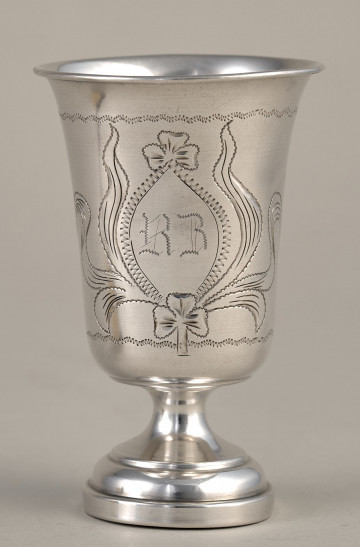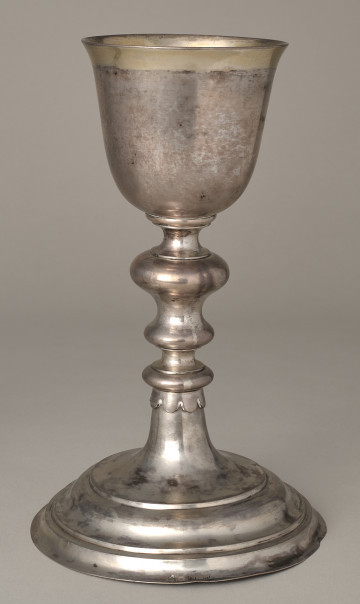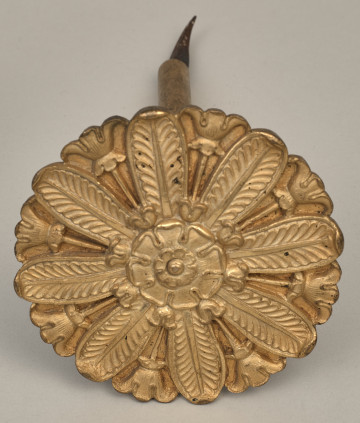
Small cup
20th century
Castle Museum in Łańcut
Part of the collection: Złotnictwo
Candelabra is a tall standing candle holder made of metal, usually painted and gilded, known since antiquity. In the 17th century the most common candlesticks were double (for two candles), in the 18th century candlesticks with three arms and in the 19th century multi-arm candlesticks. Candles were already known in Antiquity, their wicks were made of linen covered with beeswax, however, in the homes of less wealthy users, animal fat was used instead of wax (tallow candles). The candelabras in question make part of the museum’s collection and decorate one of the fireplaces on the first floor. They are all Classicist, four-armed, designed for five candles and large. A quadrilateral herm shaft, decorated in the upper part with a motif of a bucranion (ox heads), in the lower part with a motif of a ribbon tied to a bow, a cartouche and a campanula. The shaft rests on a quadrilateral foot with cut corners. On the shaft there is a sleeve in the form of a vase, decorated with festoons; it has s-shaped arms formed of acanthus tendrils and ending with sleeves. The sleeves has the form of a vase with plate-shaped candle rings, decorated with a band of pearls at the edges. The fifth sleeve set on the end of the shaft (with candle ring identical to the others). The arms at the base of the sleeves (by the shaft) are decorated with decorative laurel branches. The edge of the foot is decorate with pearling and its diagonals with acanthus leaves. On the foot, an artistically formed cartouche with the Pilawa and Korczak coats of arms (twice repeated) and the monogram “ZAP”? (also twice repeated) under a count crown. On the shaft the marks “Malcz”, in Warsaw, 12, anchor. Karol Filip Malcz was born in 1797 in Warsaw and died in Ozorków near Łódź. Karol learned his craft in the workshop of his grandfather (also a goldsmith), and later apprenticed in various workshops in Germany, the Netherlands, England, France, Italy, Hungary and Austria. After returning to Poland in 1927, he received the title of craft master and from 1928, he ran his own workshop at Krakowskie Przedmieście street in Warsaw. He signed his products with the name mark “Malcz”: as well as with his trademark: an anchor in an oval field. To this day, Malcz’s products are widely sought after by collectors and art connoisseurs, having a significant place in any private or museum collection.
Author / creator
Dimensions
height: 58.5 cm
Object type
goldsmithing
Technique
mill forming
Material
silver
Creation time / dating
Creation / finding place
Owner
Castle Museum in Łańcut
Identification number
Location / status

20th century
Castle Museum in Łańcut

1862
Castle Museum in Łańcut

20th century
Castle Museum in Łańcut
DISCOVER this TOPIC
National Museum in Szczecin
DISCOVER this PATH
Educational path